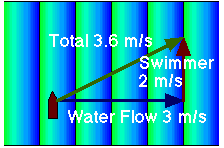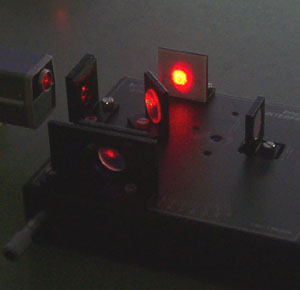Ether
 During
this class, we have looked at the propagation of waves through
several different media, waves on a
string or sound waves for
example. Most importantly, we looked at electromagnetic
waves. We said then that these waves propagate
through the vacuum and do not need a medium.
During
this class, we have looked at the propagation of waves through
several different media, waves on a
string or sound waves for
example. Most importantly, we looked at electromagnetic
waves. We said then that these waves propagate
through the vacuum and do not need a medium.
 This
last fact was not always so clear. In fact, until the the end of the
19th century everybody believed that all waves need a physical medium
to propagate in, that waves could not simply travel through a vacuum.
Since one knows, of course, that sunlight moves through space for the
150 Million km long trip from the Sun to Earth, this required that
all of the space between Earth and Sun was filled with some kind of
medium. This medium that was proposed to exist was called
"ether".
This
last fact was not always so clear. In fact, until the the end of the
19th century everybody believed that all waves need a physical medium
to propagate in, that waves could not simply travel through a vacuum.
Since one knows, of course, that sunlight moves through space for the
150 Million km long trip from the Sun to Earth, this required that
all of the space between Earth and Sun was filled with some kind of
medium. This medium that was proposed to exist was called
"ether".
How can you detect the presence of the ether when you do not see
it? Well, let's remind ourselves of the problem of a swimmer
crossing a stream (the top graphic on the right was shown there
and is reproduced to refresh your memory): as the swimmer moves
through the river, he drifts downstream due to the motion of the
medium he is moving in, in this case the river (see the animation).
So if the Earth is moving through the ether, then one should be able
to detect the ether from the change in the velocity of light moving
in different directions, one perpendicular to the motion of the ether
and one parallel. In particular, since the velocity vector of the
Earth relative to the ether changes all the time, because the Earth
is on orbit around the Sun (shown on the left at the present time and
then 6 month later), that motion should leave a detectable effect if
one performs that same experiment twice, six months apart.
 This
is exactly what Albert Michelson and Edward Morley at the Case
Institute in Cleveland, Ohio, did in 1887. They used an extremely
cleverly designed precision instrument, which is now called the Michelson-Morley
interferometer, to measure the motion of Earth through the ether. (We
have already discussed the workings
of interferometers, and the picture on the left is shown again here
to trigger your memory.)
This
is exactly what Albert Michelson and Edward Morley at the Case
Institute in Cleveland, Ohio, did in 1887. They used an extremely
cleverly designed precision instrument, which is now called the Michelson-Morley
interferometer, to measure the motion of Earth through the ether. (We
have already discussed the workings
of interferometers, and the picture on the left is shown again here
to trigger your memory.)
The result of this experiment was an incredible surprise at the
time: The speed of light is exactly the same in
all directions, and no motion relative to the ether can be
detected.
People struggled with an explanation for this astounding result,
and Lorentz and Fitzgerald came up with the idea that objects moving
through the ether become length-contracted when they move through the
ether. It took the genius of Albert Einstein, however, to make the
conceptional leap required for the new insight and it's astounding
consequences: ether does not exist. Thinking through the fact that
the speed of light is constant for all observers independent of the
observer's motion led Einstein much further to the formulation of the
theory of relativity, the topic of this chapter.
©
MultiMedia Physics
2000
 During
this class, we have looked at the propagation of waves through
several different media, waves on a
string or sound waves for
example. Most importantly, we looked at electromagnetic
waves. We said then that these waves propagate
through the vacuum and do not need a medium.
During
this class, we have looked at the propagation of waves through
several different media, waves on a
string or sound waves for
example. Most importantly, we looked at electromagnetic
waves. We said then that these waves propagate
through the vacuum and do not need a medium. This
last fact was not always so clear. In fact, until the the end of the
19th century everybody believed that all waves need a physical medium
to propagate in, that waves could not simply travel through a vacuum.
Since one knows, of course, that sunlight moves through space for the
150 Million km long trip from the Sun to Earth, this required that
all of the space between Earth and Sun was filled with some kind of
medium. This medium that was proposed to exist was called
"ether".
This
last fact was not always so clear. In fact, until the the end of the
19th century everybody believed that all waves need a physical medium
to propagate in, that waves could not simply travel through a vacuum.
Since one knows, of course, that sunlight moves through space for the
150 Million km long trip from the Sun to Earth, this required that
all of the space between Earth and Sun was filled with some kind of
medium. This medium that was proposed to exist was called
"ether". This
is exactly what Albert Michelson and Edward Morley at the Case
Institute in Cleveland, Ohio, did in 1887. They used an extremely
cleverly designed precision instrument, which is now called the Michelson-Morley
interferometer, to measure the motion of Earth through the ether. (We
have already discussed the workings
of
This
is exactly what Albert Michelson and Edward Morley at the Case
Institute in Cleveland, Ohio, did in 1887. They used an extremely
cleverly designed precision instrument, which is now called the Michelson-Morley
interferometer, to measure the motion of Earth through the ether. (We
have already discussed the workings
of